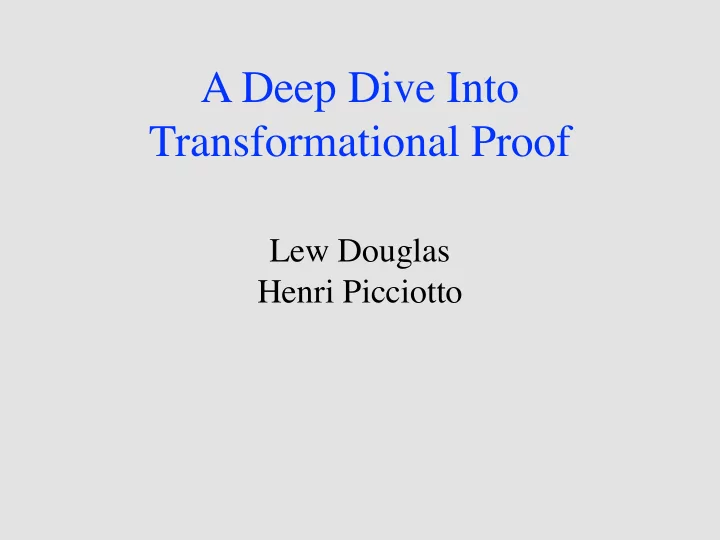

A Deep Dive Into Transformational Proof Lew Douglas Henri Picciotto
The Common Core introduces geometric transformations in 8th grade. We will assume you are familiar with those basics, and focus this presentation on proof from a transformational point of view.
The Common Core is open to interpretation We don’t always agree with each other on the best choices, and we encourage you to make your own choices.
A key innovation of the CCSSM in geometry is the redefinition of congruence on a transformational basis. (and a parallel change for similarity, which we will not discuss today because of time constraints)
This is a good idea ◊ mathematically ◊ pedagogically
Mathematically ◊ Connections to algebra: - Functions: composition, inverses, notation - Transformations of graphs - Coordinate transformations e.g. T(x, y) = (-x, y) ◊ Geometric interpretation of complex numbers ◊ Symmetry
Pedagogically a more intuitive foundation for geometry
Minimal interpretation of the CCSSM 1. Use transformations to justify SSS, SAS, ASA 2. Continue along traditional path
Ambitious interpretation (ours) ◊ New definitions and assumptions ◊ New approaches to proof
1. Rethinking Basics
Construction Assumptions ◊ two distinct lines meet in at most one point ◊ two distinct circles meet in at most two points ◊ a line and a circle meet in at most two points
Example (SSS) 1. Make ∆ ABC in GeoGebra with the polygon tool 2. Use the compass, point, and segment tools to make another triangle with sides equal to ∆ ABC’s. 3. Save!
Precise definitions of reflection, rotation, and translation
Reflection A reflection in a line b maps any point on b to itself, and any other point P to a point P' so that b is the perpendicular bisector of PP'.
Rotation Given a point O and a directed angle θ * , the image of a point P ≠ O under a rotation with center O and angle θ is a point P' on the circle centered at O with radius OP, such that ∠ POP' = θ . The image of O is O. * θ is positive for counterclockwise, negative for clockwise.
Translation ! " V Given a vector V , the image of a point P under a translation by V is ! " ! " !! V PP' a point P' such that the vector PP = V.
Orientation
What is preserved
Composition of two reflections in ◊ parallel lines ◊ intersecting lines
(Thus we don’t need axioms about what translations and rotations preserve.) Reflection preserves distance and angle measure.
Particular case The composition of two reflections in perpendicular lines is a 180° rotation around their intersection. (a.k.a half-turn , or reflection in a point .)
Reflection, rotation, and translation are rigid motions , or isometries.
Parallel Postulate Through a point outside a given line l , there is a unique line parallel to l .
Parallels and Transversal Two lines are parallel if and only if, when cut by a transversal, an angle created on one line is a translation image of an angle created on the other.
Angle basics ◊ Sum of angles in a triangle ◊ Sum of interior angles in a quadrilateral (formally or informally?)
Rotating a segment 180° around its midpoint. A' = B and B' = A
Rotating a line 180° around a point not on the line
2. Proving Theorems
Perpendicular Bisector Theorem A point P is equidistant from two points A and B if and only if it lies on their perpendicular bisector.
Theorem: There is a reflection that maps any given point P into any given point Q.
Theorem: If two segments AB and CD have equal length, then one is the image of the other with C the image of A and D the image of B, under either one or two reflections. (In other words, if segments have equal length, they are congruent.)
Triangle congruence: prove SSS ◊ Use the file you created earlier ◊ Use isometries to get from the original to the SSS copy (SAS, ASA will work in similar ways)
Definition: A symmetry of a figure is an isometry for which the figure is invariant. (The image is the pre-image. Individual points need not be fixed.) lines of symmetry
Two-fold rotational symmetry (180°) Z Three-fold rotational symmetry (120°)
Symmetry definitions for isosceles and equilateral triangles
Symmetry definitions for the special quadrilaterals
Our definitions
Proofs of properties
The image of a vertex of a polygon in a line of symmetry is also a vertex.
One vertex of an isosceles triangle lies on the line of symmetry.
The diagonals of a parallelogram bisect each other.
Properties of an isosceles trapezoid.
1. Properties of an isosceles triangle. 2. Properties of a kite. 3. An equilateral triangle has 3-fold rotational symmetry.
Proving that a triangle or quadrilateral is a special type (that is, it satisfies the symmetry definition)
If a triangle has two equal angles, it is isosceles.
If a diagonal of a quadrilateral bisects a pair of opposite angles, the quadrilateral is a kite.
1. If the diagonals of a parallelogram bisect each other, the quadrilateral is a parallelogram. 2. If an angle bisector of a triangle is also an altitude, the triangle is isosceles.
1. If the diagonals of a parallelogram bisect each other, the quadrilateral is a parallelogram.
2. If an angle bisector of a triangle is also an altitude, the triangle is isosceles.
Questions?
Tomorrow ◊ 9:30 Computing Transformations (Algebra 2 / Precalculus) ◊ 3:30 Transformational Proof (Geometry) Summer (in Oakland) June 26-27: Hands-On Geometry (grades 6-10) June 28-30: Transformational Geometry (grades 8-11)
Many PDFs on this topic are available at www.MathEducationPage.org/transformations
Recommend
More recommend